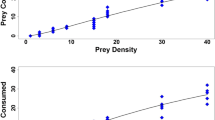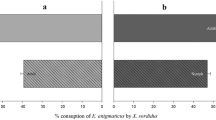Abstract
Predatory behaviour and reproductive output of the ladybird beetle Stethorus tridens Gordon as function of the tomato red spider mite (TRSM), Tetranychus evansi Baker & Pritchard, densities was investigated in the laboratory. Adult female of S. tridens were isolated in cylindrical plastic arenas, containing a leaf disc of Solanum americanum Mill. with 5, 20, 40, 60, 80 or 100 T. evansi nymphs. The number of prey consumed and eggs laid were evaluated daily for ten consecutive days, starting at the oviposition. Oviposition of S. tridens was positively correlated with prey consumption and lower threshold prey consumption for S. tridens laying eggs was 16.3 mites per day. The instantaneous rate of attack (ca. discovery area) and the handling time were 0.0062 h−1 and 0.83 h, and 0.00254 h−1 and 0.78 h, respectively, for predators at the 1st- and 10th-oviposition day. The predator exhibited a type II functional response at 1st- and 10th-oviposition day with a maximum consumption per predator of 33 T. evansi nymphs per day at the highest prey density. The ladybird beetle S. tridens is often collected associated with red spider mite colonies on solanaceous wild plants and the results suggest the potential of this ladybird beetle to control T. evansi in tomatoes crops.


Similar content being viewed by others
References
Baker EW, Pritchard AE (1960) The Tetranychoid mites of Africa. Hilgardia 29:455–574
Britto EPJ, Silva FR, Fiaboe KKM, Gondim MGC Jr, Moraes GJ, Delalibera I Jr, Knapp M (2005) Flutuação populacional dos predadores associados a Tetranychus evansi Baker & Pritchard (Acari: Tetranychidae) em solanáceas em Recife. In: Anais do IX Simpósio de Controle Biológico. SEB, Recife, PE, Brazil, pp 169
Casas J, Gurney WSC, Nisbet R, Roux O (1993) A probabilistic model for the functional response of a parasitoid at the behavioural time-scale. J Anim Ecol 62:194–202
Ferragut F, Escudero LA (1999) Tetranychus evansi Baker & Pritchard (Acari, Tetranychidae), una nueva arana roja en los cultivos horticolas espanoles. Bol Sanid Veg Plagas 25:157–164
Ferreira MA, Carmona MM (1995) Acarofauna do tomateiro em Portugal. Adv. Entomol. Ibérica, pp 385–392
Fiaboe KKM, Britto EPJ, Silva FR, Gondim MGC Jr, Moraes GJ, Ogol COK, Knapp M (2005) Biologia de Stethorus tridens Gordon (Insecta: Coccinellidae) alimentando-se de Tetranychus evansi Baker & Pritchard (Acari: Tetranychidae). In: Anais do IX Simpósio de Controle Biológico. SEB, Recife, PE, Brazil, pp 169
Gotoh T, Nozawa M, Yamaguchi K (2004) Prey consumption and functional response of three acarophagous species to eggs of the two-spotted spider mite in the laboratory. Appl Entomol Zool 39:97–105
Hassell MP (1978) The dynamics of arthropod predator-prey systems. Princeton University Press, Princeton
Holling CS (1959) Some characteristics of simple types of predation and parasitism. Can Entomol 91:385–398
Holling CS (1961) Principles of insect predation. Annu Rev Entomol 6:163–182
Houck MA (1991) Time and resource partitioning in Stethorus punctum (Coleoptera: Coccinellidae). Environ Entomol 20:494–497
Hull LA, Asquith D, Mowery PD (1977) The functional responses of Stethorus punctum to densities of the European red mite. Environ Entomol 6:85–90
Jeppson LR, Keifer HH, Baker EW (1975) Mites injurious to economic plants. University of California Press, Berkeley
Juliano SA (1993) Nonlinear curve fitting: predation and functional response curves. In: Scheiner SM, Gurevitch J (eds) Design and analysis of ecological experiments. Chapman and Hall, New York, pp 159–182
Knapp M, Wagener B, Navajas M (2003) Molecular discrimination between the spider mite Tetranychus evansi Baker and Pritchard, an important pest of tomatoes in southern Africa, and the closely related species T. urticae Koch (Acarina: Tetranychidae). Afr Entomol 11:300–304
McMurtry JA, Johnson HG (1966) An ecological study of the spider mite Oligonychus punicae (Hist) and its natural enemies. Hilgardia 37:363–402
McNamara JM, Buchanan KL (2005) Stress, resource allocation, and mortality. Behav Ecol 16:1008–1017
Migeon A (2005) Un nouvel acarien ravageur en France : Tetranychus evansi Baker & Pritchard. Phytoma 579:38–43
Moraes GJ, Lima HC (1983) Biology of Euseius concordis (Chant) (Acarina: Phytoseiidae) a predator of the tomato russet mite. Acarologia 24:251–255
Moraes GJ, McMurtry JA (1985) Comparison of Tetranychus evansi and T. urticae (Acari: Tetranychidae) as prey for eight species of Phytoseiid mites. Entomophaga 30:393–397
Oatman ER, Fleschner CA, McMurtry JA (1967) New, highly destructive spider mite present in southern California. J Econ Entomol 60:477–480
Olkowski W, Zhang A, Siers P (1990) Improved biocontrol techniques with lady beetles. Practioner Monit. Field Pest Manag 12:1–12
Peterson PG, McGregor PG, Springett BP (2000) Density dependent prey-feeding time of Stethorus bifidus (Coleoptera: Coccinellidae) on Tetranychus lintearius (Acari: Tetranychidae). N Z J Zool 27:41–44
Ramalho FS, Flechtmann CHW (1979) Niveis de infestacao de Tetranychus (T.) evansi Baker, Pritchard,1960 em diferentes fases de desenvolvimento do tomateiro. Rev Agric 54:51–56
Rosa AA, Gondim MGC Jr, Fiaboe KKM, Moraes GJ, Knapp M (2005) Predatory mites associated with Tetranychus evansi Baker & Pritchard (Acari: Tetranychidae) on native solanaceous plants of coastal Pernambuco State, Brazil. Neotrop Entomol 32:689–692
SAS Institute (1999–2001) SAS/STAT user’s guide, version 8.02, TS level 2 MO. SAS Institute Inc., Cary, North Carolina
Santa-Cecilia LVC, Gonçalves-Gervásio RCR, Torres RMS, Nascimento FR (2001) Aspectos biológicos e consumo alimentar de larvas de Cycloneda sanguinea (Linnaeus, 1763) (Coleotera: Coccinellidae) alimentadas com Schizaphis graminum (Rondani), 1852) (Hemiptera: Aphididae). Ciênc Agrotéc 25:1273–1278
Silva P (1954) Um novo ácaro nocivo ao tomateiro na Bahia (Tetranychus mariane McGregor, 1950–Acarina). Bol Inst Biol Bahia 1:18–37
Ullah I (2000) Aspects of the biology of the ladybird beetle Stethorus vagans (Blackburn) (Coleoptera: Coccinellidae). PhD dissertation, University of Western Sydney, Richmond, Australia
Acknowledgements
This study is part of a collaborative project between ICIPE, ESALQ/USP and UFRPE to develop strategies for the control of T. evansi, funded by a grant provided by the German Federal Ministry for Economic Cooperation and Development (BMZ). The manuscript benefited greatly from the comments of two anonymous reviewers and associate editor for BioControl.
Author information
Authors and Affiliations
Corresponding author
Additional information
Handling editor: Eric Lucas.
Rights and permissions
About this article
Cite this article
Britto, E.P.J., Gondim, M.G.C., Torres, J.B. et al. Predation and reproductive output of the ladybird beetle Stethorus tridens preying on tomato red spider mite Tetranychus evansi . BioControl 54, 363–368 (2009). https://doi.org/10.1007/s10526-008-9178-5
Received:
Accepted:
Published:
Issue Date:
DOI: https://doi.org/10.1007/s10526-008-9178-5




